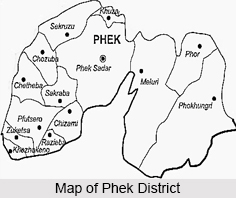 The mountainous region of Phek district spreads over a total area of 2,026 sq. km and is one of the districts of Nagaland. The district headquarters are in the town of Phek, which lies at the lowest altitude of the district at 1,524 m. The highest mountain in the Phek district is Zanibu (7,900 ft) and the largest rivers are the Tizu, Lanyi, Arachu, along with three most important lakes called the Shilloi, Chida and Dzudu.
The mountainous region of Phek district spreads over a total area of 2,026 sq. km and is one of the districts of Nagaland. The district headquarters are in the town of Phek, which lies at the lowest altitude of the district at 1,524 m. The highest mountain in the Phek district is Zanibu (7,900 ft) and the largest rivers are the Tizu, Lanyi, Arachu, along with three most important lakes called the Shilloi, Chida and Dzudu.
History of Phek District
The word Phek is derived from the term "Phekrekedze", which means watch tower. Phek was once a sub division under Kohima District and was looked after by an additional Deputy Commissioner with effect from 1957 till it was upgraded to a full fledged district on 21st Dec. 1973. The Phek District is in inhabited by three major tribes, the Kheza, Chokhri and the Pochury. There are at least five linguistics groups in the district, namely the Chokri, Khezha, Pochury, Sapu, and Semas.
Climate of Phek District
The Phek district experiences moderately warm summers with an average temperature of 27 degree Celsius and not going over 32 degrees Celsius. Winters are cold, in comparison to the nearby plains of Assam, with the temperature dropping to 0 degree Celsius in the coldest months of January and February. The end of May is the beginning of the monsoon season and the district receives an annual average rainfall of 1,527 mm.
Economy of Phek District
Agriculture is the main occupation in the Phek district with Jhum cultivation and Terrace Rice Cultivation being predominant. The main crops grown in the region are rice, maize, and millets etc. Besides agriculture, the people are also engaged in salt making, especially in the Meluri area, paddy cum fish rearing and making fruit juice are also the different types of occupations. Other than these the people are expert craftsmen, excellent in making pots, baskets, sculptures, furniture etc.
Demographics of Phek District
As per the reports of Census India 2011, the total population of the Phek district is 1, 63,418 with an average sex ratio of 951 females for every 1000 males. The literacy rate of the district is about 79 percent. And the majority of the population inhabiting the region practise the religion of Christianity, followed by Hinduism, Islam, Buddhism and a handful practising Jainism or Sikhism.
Culture of Phek District
The tribes of Chakhesangs and Pochurys are known for their rich culture and traditions. There are varieties of traditional attires and ornaments. The melodies, folk songs and the lively folk dances are feast for the ears and eyes. The people are expert craftsmen and excel in making pots, baskets, sculptures and furniture. The societies are patrimonial but women enjoy a high status in their families. The customary laws are unwritten but practiced by all villages. These laws are binding to members of the society and were passed on from generation to generation by the word of mouth.
Visiting Information on Phek Distict
The Dimapur railway station and the airport are the closest at a distance of about 190 km and 183 km respectively from Phek district.



















